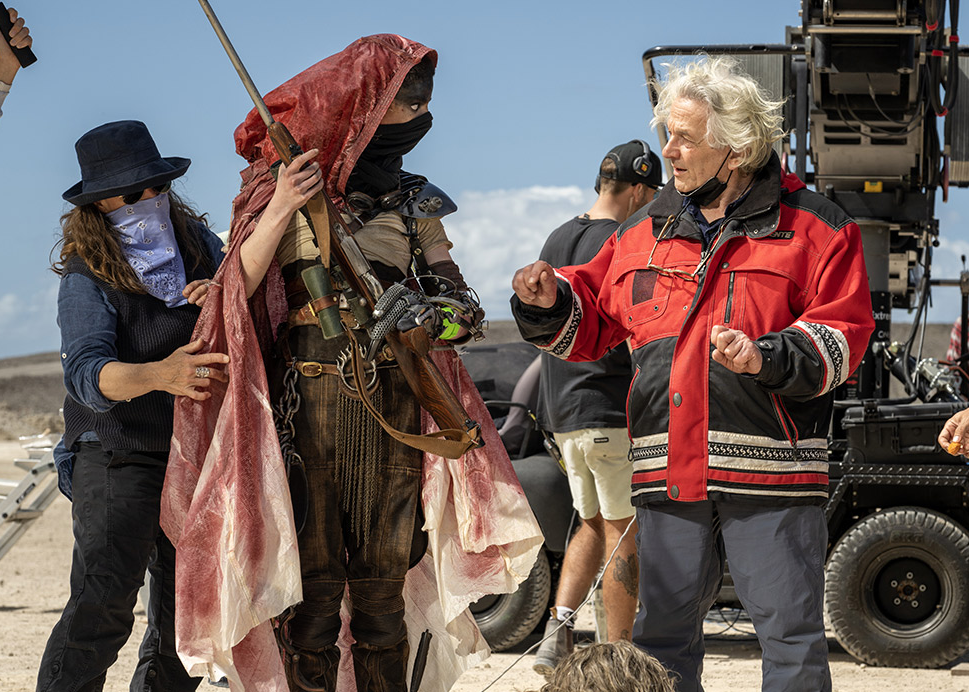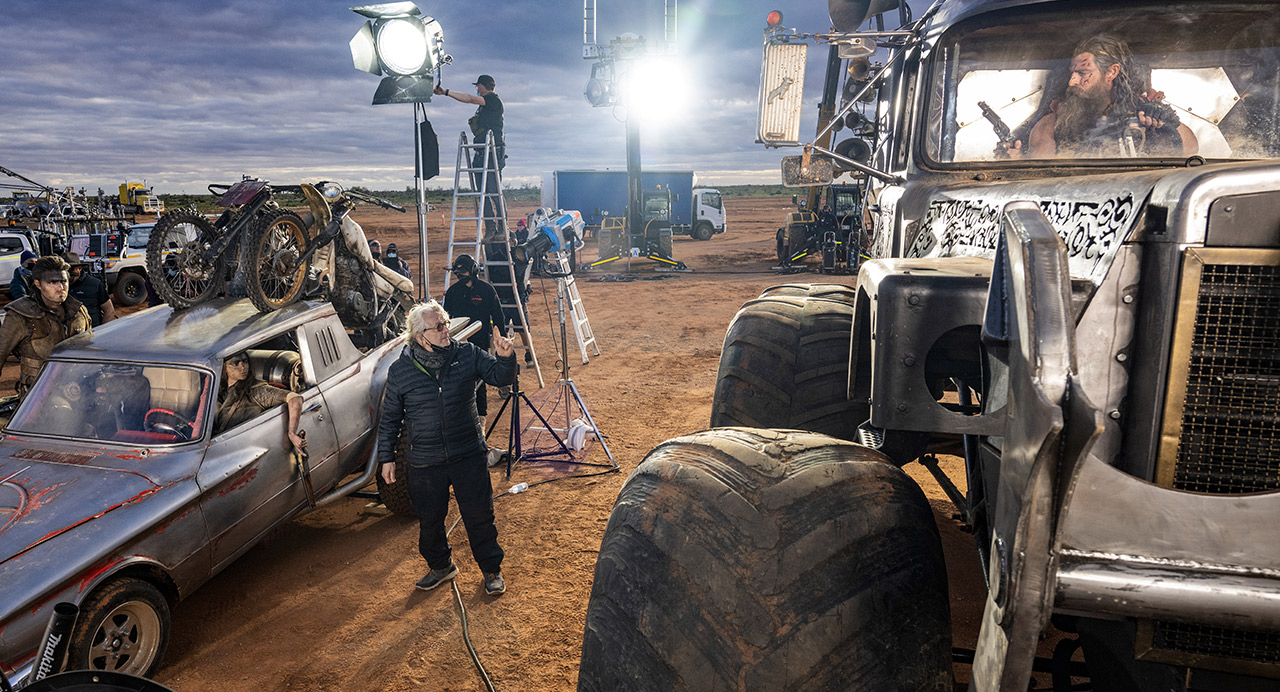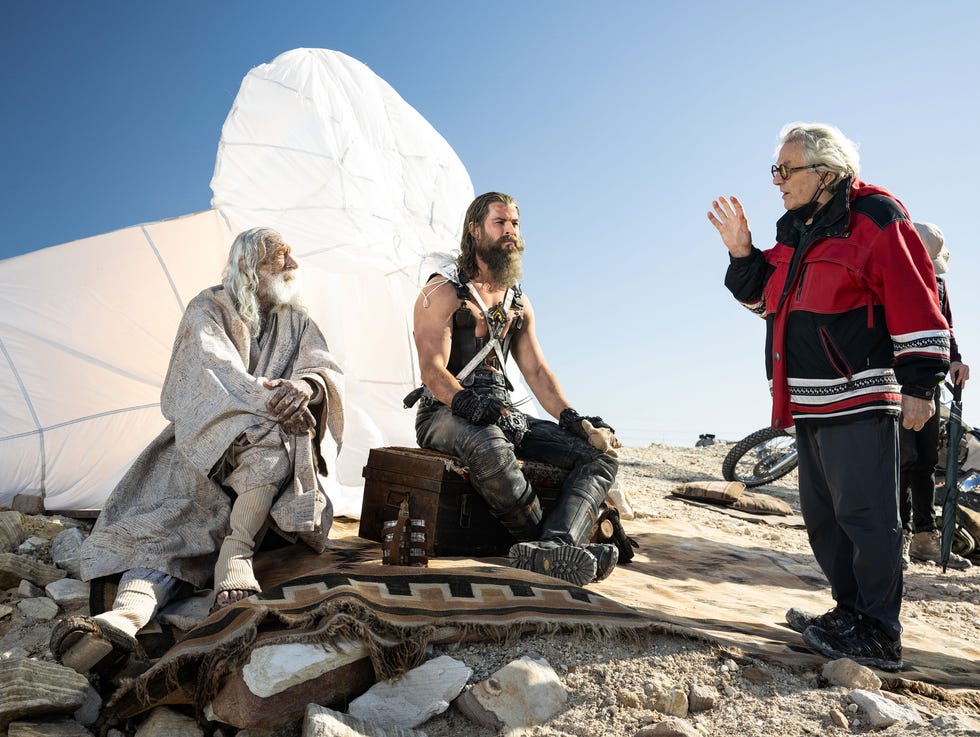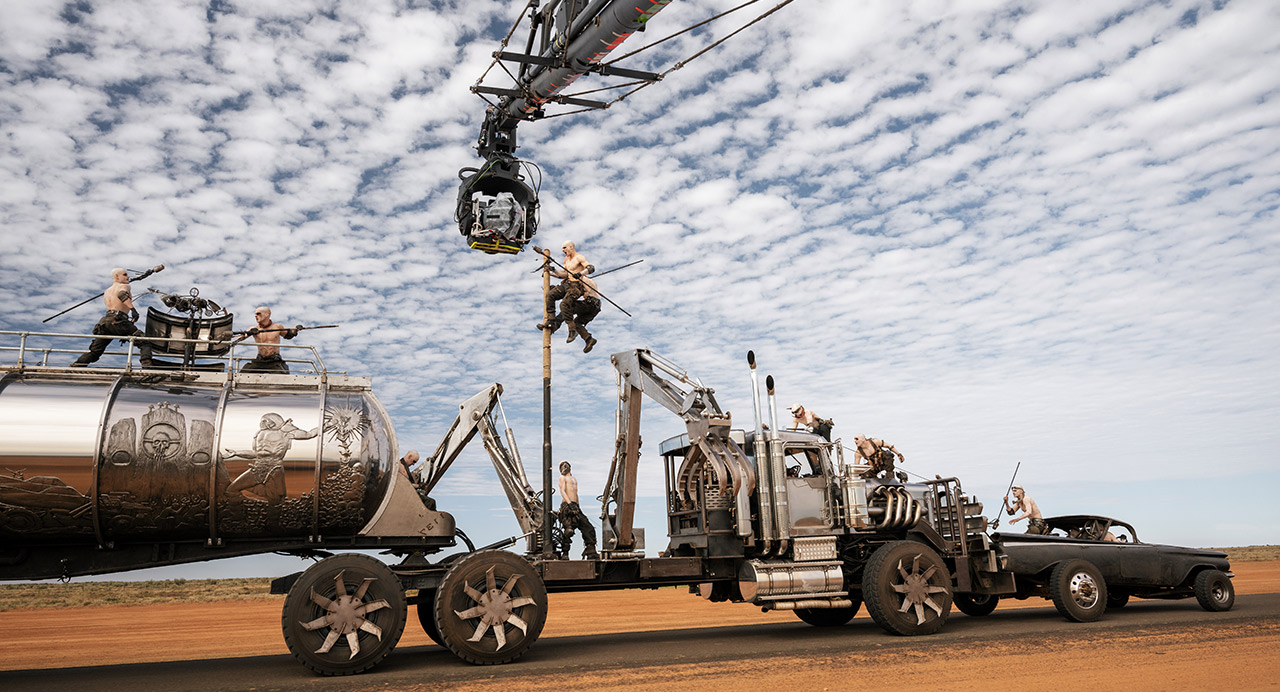GEORGE MILLER HAS been making things majestically, strikingly, and convincingly blow up on screen for more than 40 years. But explosions aren’t part of the equation right now, as we sit on a couch several stories up in the Warner Bros. Discovery office in Midtown Manhattan, and he politely requests permission he certainly doesn’t need from me to take a sip of a large Starbucks drink that just arrived. “Do you mind?” he asks, mid-conversation, in a completely earnest tone, his face framed by a pair of signature round-frame glasses. That face is one most likely recognize from the time it made several appearances during the Oscars broadcast back in 2016 as Mad Max: Fury Road cleaned up, winning six Academy Awards.
Now, almost a decade (and another feature film, 2022’s Three Thousand Years of Longing) later, and Miller has finally returned to the Wasteland of post-apocalyptic Australia with Furiosa: A Mad Max Saga. The film, which he mapped out and conceived before Fury Road was made, slows things down from its signature breakneck pace. It tells the backstory of Furiosa, originally played by Charlize Theron and now played primarily by Anya Taylor-Joy, over the course of nearly 20 years as she chases revenge against the dipshit warlord who wronged her (a transformative, evil, and hilarious Chris Hemsworth) and becomes the robot-armed badass we met in the previous film.

WARNER BROS. ENTERTAINMENT
Miller, at 79 years old, is putting out the 11th feature film of a directorial career that’s also included dark comedy (The Witches of Eastwick), pure drama (Lorenzo’s Oil), cutting edge family fare (the Babe and Happy Feet films), and even an aborted superhero epic (Justice League: Mortal, which is its own whole thing). But nothing defines his career like the Mad Max franchise, which kicked his journey off with the low-budget but nonetheless thrilling original in 1979, and marks a world he’s revisited now four different times in the 45 years since. And as with all of those films, Furiosa is intricately-planned, full of scenes with countless moving pieces and changing components that needed to fit together perfectly to work; these movies are like a 1,000 piece Lego set that, somehow, only Miller has the step-by-step directions to.
But, himself the creator of a world where penguins joyously dance via motion-capture animation, Miller uses a different metaphor to explain how he sees things.
“To be honest, film is like visual music,” he says, choosing his words carefully just a few days before Furiosa was set to be released. “It’s not just one shot, it’s a progression of shots. It’s not just one note, or one chord, it’s a progression of those notes and chords that give you the experience in the music. And so it is with film – it’s visual music.“
Miller has continued to make his own brand of beautiful, chaotic, fire-filled stunt bonanzas, and proves he’s still operating at the very top of his powers with the visually-stunning epic of Furiosa. We spoke with the legendary director about dialogue and stunts in his movies, the incredible work of his lead actors, and far more.

WARNER BROS. ENTERTAINMENT
MEN’S HEALTH: You said in your New Yorker interview that “action sequences are the equivalent of dialogue scenes in other movies.”
GEORGE MILLER: That’s right.
MH: I’m curious how you view the function of stunts within that equation.
GM: Well, first of all, story has primacy over everything else. Then, it’s all about the characters. It’s all about the interaction of characters. All action sequences should drive the interaction of the characters, and therefore progress the story. That’s the underlying strategy of all action scenes.
Then, you’re basically using conflict—which is the essence of drama. Someone has an intention, and you put up obstacles, and so on, and there are rising conflicts. There have to be rising conflicts, they can’t dance around the same spot, because then it gets boring. And then they have to progress, and you learn something about the characters. So, a sequence like the “Stowaway to Nowhere” really tells you a lot about those two key characters—Furiosa and Praetorian Jack—and, under extreme conditions, how they handle it, and what’s revealed about them. What is their essence?
That’s the basis of it.
MH: What do you want someone’s takeaway to be at the end of a sequence like that?
GM: You want to know the characters and where they’re going. I mean, this is the story of Furiosa, who is taken away as a child from her family and her community, and spends virtually the next 20 years trying to get home. She’s forged in the crucible of this wasteland. This is a very harsh world, and an extreme world, and her character is forged. What is intrinsic to her as a child, her skills, she’s called on to really survive by the use of whatever internal resources she has. And she becomes what she does at the end.
For me, that’s key. She has to learn on the run. She has no time to think about it, or whatever. She’s got to improvise her way through it, and we see what she’s made of. And not only do we see it, but we also see that Praetorian Jack, who drives this big new War Rig, the best thing ever created in the wasteland, sees it.
So, basically, we’ve forged a relationship between these two characters.
MH: It took you 27 takes to get the most important shot in the “Stowaway” sequence just right. Do you still feel a relief when everything finally clicks perfectly, even having done what you do for so long?
GM: Oh yeah. Of course. You know, whether it’s just the wind blowing the right way so that someone’s hair doesn’t blow across their face, but it blows in an interesting way. Whether the sun’s in the right position, and when you know it, and you see it, it’s captured in the camera, and you say ‘OK, we got that one.’ You feel a sense of small, incremental accomplishments. And that sustains you through the shoot. And then you get it in the cutting room, and you put all the pieces together, and it starts to emerge. That’s always really interesting to me.

WARNER BROS. ENTERTAINMENT
MH: How has the evolution of the technology behind stunts and action changed your ability as a storyteller and what you want to put on the screen?
GM: Big time. One of the reasons why I’m still making films, and indeed Mad Max films, is I’m really still curious about story. Not only how to to tell story, but why we tell story. And that goes hand-in-hand with the ever-evolving technology. For instance, when we made the Babe movies, the first one was done at Universal, because it was the beginning of digital CGI. Universal had just done Jurassic Park, which was the first big CGI movie—there were 63 shots of dinosaurs in that. And the studio, at the time, said ‘We know how it works, and we know it can work with the animals.’ And so that’s what we did with Babe.
By the time we got to do Happy Feet almost a decade later, the cameraman on the Babe movies, Andrew Lesnie, he went and shot Lord of the Rings. When he came back from the first Lord of the Rings, he showed me the first motion capture of Gollum, and we had the story of the penguins. And I thought ‘That’s how we can make these penguins dance!’ And that drove Happy Feet.
For instance, the “Stowaway” sequence shot for 78 days. Now, some of the skies in those shots were brilliant—and others weren’t. But you have to keep a consistency of the sky. So, you’re able to take your favorite skies, and make sure they’re consistent right through the story.
Little things like that. But most of all, I would say that cameras now are not only relatively small, they’re much higher resolution, and you don’t have to be stopping all the time to reload the celluloid, because you’ve got a computer chip recording at 4-8K, and you can run it for 45 minutes. It’s not costing you anything. So, if you’ve got, say, an explosion, you’ve not only got to start the camera, but you’ve got to get your crew out before the explosion. And if you’re shooting the explosion with high-speed cameras, you’ve only got a very short time before you’re running out of celluloid. I’m sure it’s happened many times—they run out of film just before the main action happened on camera. Now, you don’t have to worry about things like that.

WARNER BROS. ENTERTAINMENT
MH: Mad Max: The Wasteland has been mentioned as something you’ve got ready to go if you get the opportunity. What more can you share about that?
GM: I always prefer not to talk about it until we’re making it. But certainly I would like to—if Furiosa works well enough, I would certainly look towards it.
MH: You and Edgar Wright have both talked about how you met and he recommended Anya Taylor-Joy for Furiosa. How did you know that she would be game for all the stunts and intensity that the role entails?
GM: I could see it in her work. Edgar was insistent that she’s got it all—she’s got everything that an actor needs. Actors have to be physically athletic, they have to be intellectually athletic, and they have to be emotionally athletic. They’re warriors, in a way, particularly to do these films. Anya is someone who studied ballet from the age of 3, and up to the age of 15—I’ve worked with dancers, and I’ve realized how they have this relaxed discipline, and the precision is really important. She was almost hard-wired for this because of that. I could see it in the work she did, and it proved to be the case.
She worked incredibly hard, she did a lot of her own stunts. She’s got that ability. Again, she’s very, very physically and emotionally agile.
MH: How does Chris Hemsworth’s work in Furiosa compare to his work as Thor, and elsewhere?
GM: This is different. Chris Hemsworth—I had one meeting with him, and I realized there’s way more than meets the eye. He’s a guy of many dimensions, incredibly wise for someone so young. And when I got to know his history, and his family, I realized where they came from. Again, physically athletic, emotionally athletic, and he can bring that all together. A little bit like any athlete.
You know, you’re like a football coach when you’re a director. People have got the basic talent, and then you hone those talents, and you help them get the best of it. You help put together a team, and you have to plan, and you prepare. But in the moment of the game, it’s all handed over to the instinctive response. They can’t think about ‘I’m going to do this and that.’ They can’t think about it. All the preparation has prepared them for that, and then they pull off the moves, and when it really works, it really works. You almost don’t know how it comes together. Working with Chris, I saw that over and over again. It blew me away. I had no idea he could do the kind of stuff he was doing on screen.
Related:
This is the workout routine and diet that has Chris Hemsworth looking lean for Furiosa
Chris Hemsworth is putting in work ahead of the ‘Furiosa’ premiere















